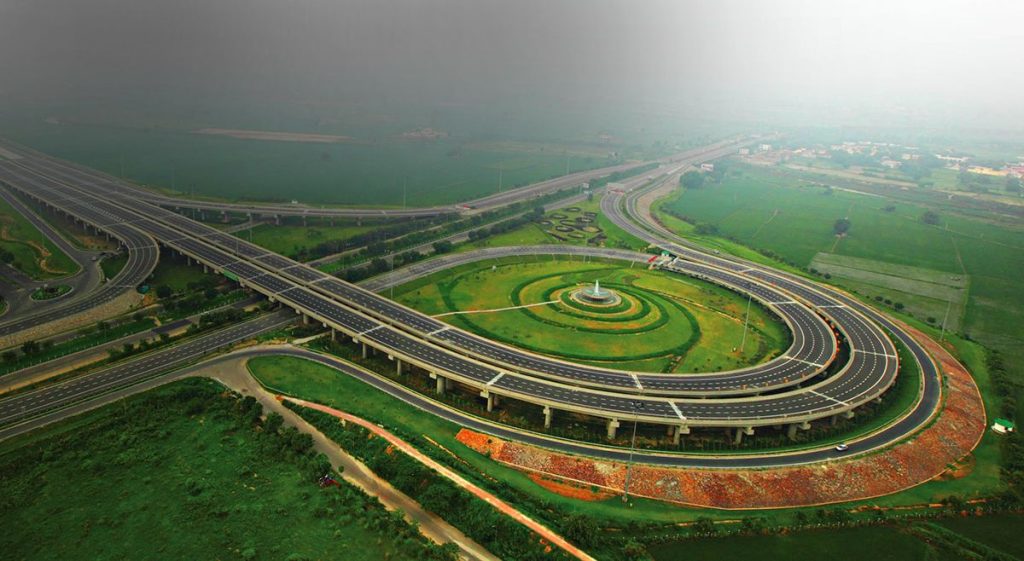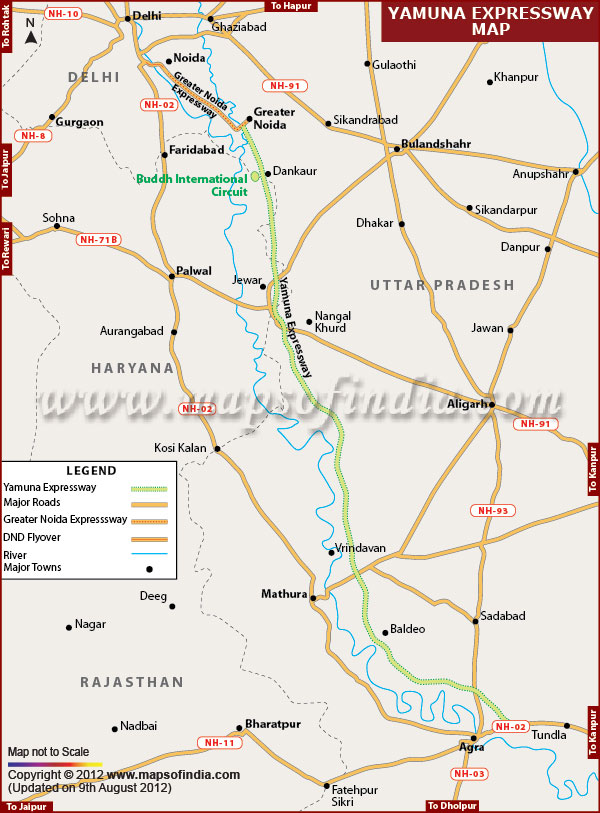The Yamuna Expressway, also known as the Taj Expressway, is a marvel of modern engineering, revolutionizing travel between Delhi, the capital of India, and Agra, the city of the iconic Taj Mahal. This high-speed, six-lane expressway stretches for 165.5 kilometers, significantly reducing travel time between these two major cities.
Yamuna Expressway: A Timeline of Development (2024)
The Yamuna Expressway, initially known as the Taj Expressway, boasts a rich history that reflects India’s growing infrastructure ambitions. Here’s a timeline highlighting key milestones in its development:
2001: A Vision Takes Root
- The year 2001 marks the birth of the Yamuna Expressway concept. Recognizing the urgent need to decongest the heavily trafficked National Highway 2 (NH-2) connecting Delhi and Agra, the Uttar Pradesh government takes the initiative.
- The Taj Expressway Authority (TEA), a statutory body, is constituted to oversee the project’s planning, execution, and management.
2003-2007: Laying the Foundation
- The period from 2003 to 2007 witnesses crucial groundwork being laid. The tender process for the construction of the expressway commences in 2003.
- However, the project encounters initial delays due to land acquisition challenges and other unforeseen circumstances.
2007-2012: Overcoming Hurdles and Achieving Completion
- By 2007, the project gains momentum, with construction work progressing steadily. The TEA is renamed the Yamuna Expressway Industrial Development Authority (YEIDA) to reflect a broader vision for industrial development along the expressway corridor.
- Despite facing hurdles like farmer protests and rising construction costs, the project finally reaches its culmination in 2012.
August 9, 2012: A Landmark Inauguration
- On August 9, 2012, the Yamuna Expressway is formally inaugurated by the then Chief Minister of Uttar Pradesh, Akhilesh Yadav. This momentous occasion marks the opening of a new era of swift and efficient travel between Delhi and Agra.

source: JSW
Post-Inauguration: Continued Growth and Significance
- Since its inauguration in 2012, the Yamuna Expressway has emerged as a vital transportation artery in North India. It has significantly reduced travel time between Delhi and Agra, promoting tourism and economic activity in the region.
- The YEIDA continues to oversee the expressway’s operation and maintenance while exploring opportunities for further development along the corridor.
Yamuna Expressway Route Map:

source: plotsinnoida
Here’s a quick rundown of key facts about this high-speed expressway:
- Length: 165.5 kilometers (102.8 miles)
- Established: 2012
- Connects: Greater Noida (Delhi NCR) to Agra
- Route: Pari Chowk (Greater Noida) – Noida – Mathura – Agra (Kuberpur on NH-2)
- Speed Limit: Up to 120 kilometers per hour (75 mph)
- Construction Cost: Approximately ₹ 12,839 crore (US$ 2.32 billion)
- Owner: Yamuna Expressway Industrial Development Authority (YEIDA)
- Benefits:
- Reduced travel time between Delhi and Agra (from 4 hours to 2 hours)
- Decongested National Highway 2 (NH-2)
- Facilitated faster movement of goods and services
- Promoted tourism and economic activity in the region
Additional Points of Interest:
- The expressway features well-maintained roads, proper signage, and emergency lanes for enhanced safety.
- Tolls are collected at designated plazas along the route. The exact fare depends on the vehicle type and distance traveled.
- The Yamuna Expressway project also envisioned the development of industrial zones along the corridor, further boosting economic growth.
Unveiling the Routes: Your Gateway to Efficiency
The Yamuna Expressway boasts a well-defined route, offering a smooth and efficient journey. Here’s a breakdown of the key points:
- Entry Point: The expressway commences at Pari Chowk in Greater Noida, a well-connected area in the National Capital Region (NCR).
- Key Destinations: The expressway seamlessly connects major cities and towns along the way, including Noida, Mathura, and finally, Agra.
- Exit Points: The expressway concludes at Kuberpur on NH-2 in Agra, providing easy access to the heart of the city and nearby tourist attractions.
Distance and Fares: Planning Your Budget-Friendly Trip
The Yamuna Expressway offers a cost-effective and time-saving alternative to traditional routes. Here’s a glimpse into the distance and fare structure:
- Distance: The total distance between Pari Chowk, Greater Noida, and Kuberpur, Agra, is approximately 165.5 kilometers.
- Toll Fares: Tolls are collected at designated plazas along the expressway. The exact fare depends on the vehicle type and distance traveled. You can use a toll calculator on the Yamuna Expressway Authority website (https://yamunaexpresswayauthority.com/) for an estimated fare.
Here’s a table with estimated toll charges for different vehicle categories (one-way trip):
| Vehicle Category | Approximate Toll Fare (as of May 2024) |
|---|---|
| Car/Jeep/Van | ₹ 500 – ₹ 700 |
| Bus/Truck | ₹ 1,000 – ₹ 1,500 |
Note: These are approximate fares and may vary depending on the specific route taken and future revisions.
Beyond the Route: Exploring the Expressway’s Features
The Yamuna Expressway offers more than just a fast connection between cities. Here are some of its key features:
- High Speeds: The expressway allows for travel speeds of up to 120 kilometers per hour, significantly reducing travel time compared to conventional routes.
- Safety Measures: The expressway prioritizes safety with features like well-maintained roads, proper signage, and emergency lanes.
- Reduced Traffic Congestion: By diverting traffic from congested national highways, the Yamuna Expressway offers a smoother and less stressful travel experience.
- Economic Benefits: The expressway fosters economic development by facilitating faster movement of goods and services between Delhi and Agra.
A Glimpse into the History: From Vision to Reality
The Yamuna Expressway was conceived in 2001 with the primary objective of decongesting the heavily trafficked NH-2 and reducing travel time between Delhi and Agra. The project was completed in 2012 and has since become a vital transportation corridor in North India.
The Yamuna Expressway stands as a testament to India’s commitment to infrastructure development. It offers a convenient, time-saving, and cost-effective way to travel between Delhi and Agra, making it a preferred choice for tourists, business travelers, and everyday commuters.
Frequently Asked Questions:
The Yamuna Expressway stretches for 165.5 kilometers (102.8 miles), significantly reducing travel time between Delhi and Agra.
Construction on the Yamuna Expressway was completed in 2012, opening a new era of efficient travel between these two major Indian cities
The expressway offers numerous benefits, including:
Reduced travel time between Delhi and Agra
Relief from congestion on National Highway 2 (NH-2)
Faster movement of goods and services
Boost to tourism and economic activity in the region
Yes, tolls are collected at designated plazas along the expressway. The exact fare depends on the type of vehicle and the distance traveled.
Suggested Article:
Hyderabad-Raipur Expressway: Complete Project Guide 2024
Surat – Chennai Expressway: Route Map, Latest News& Updates
Dwarka Expressway: Route, Toll charges & attractive for real estate investment







































